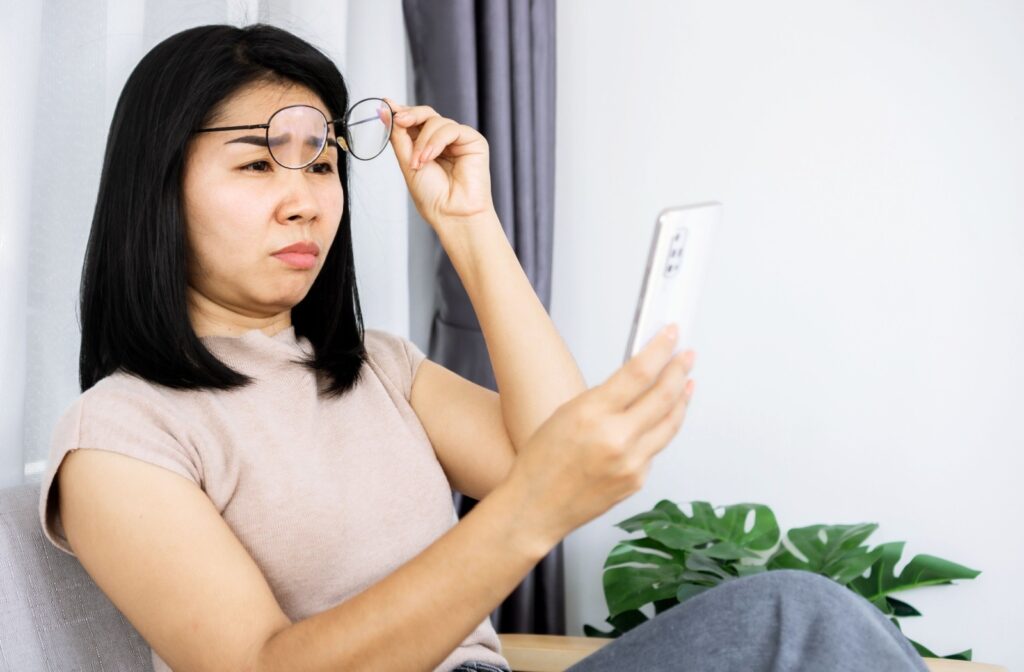Do you find yourself squinting to read road signs, or do you get headaches after reading a few pages of a book? These common vision challenges often point to nearsightedness or farsightedness, both of which are reasons why people seek out comprehensive eye care.
While both affect your ability to see clearly, they have opposite effects. The main difference is that nearsightedness makes distant objects blurry, while farsightedness makes close-up objects blurry. In either case, the first step towards correcting your vision is a thorough eye exam.
What Is Nearsightedness (Myopia)?
Nearsightedness, or myopia, is a common vision condition where you can see close-up objects with clarity, but objects farther away appear blurry. This happens when the eye focuses images in front of the retina instead of directly on it. Nearsightedness can make activities like driving or watching a presentation difficult.
Common Causes & Risk Factors
Your eye shape plays a big part in nearsightedness. If your eyeball is a bit too long or the cornea is too curved, light doesn’t focus correctly. Genetics often has a role, too—if your parents are nearsighted, you may have a higher chance of developing the condition.
Signs You Might Be Nearsighted
- Difficulty seeing distant objects, like road signs or a whiteboard in a classroom
- Headaches or eye strain from squinting to see clearly
- Needing to sit closer to the television or the front of a room
Can Screens Make Nearsightedness/Myopia Worse?
A lot of time spent on close-up activities, like using digital screens, may be linked to the development and progression of nearsightedness. This is a particular concern for children and their developing eyes, which is why we focus on services that can help manage myopia progression. Regular breaks can help reduce eye strain.
What Is Farsightedness (Hyperopia)?
Farsightedness, or hyperopia, is a condition where distant objects can be seen clearly, but close-up objects are blurry. This happens when the eye focuses light behind the retina, rather than directly on it.
How Farsightedness Affects Your Vision
With farsightedness, your eyeball may be shorter than average or you may have a cornea that is too flat. This causes light to focus at a point behind the retina. Your eyes may try to compensate by focusing too hard, which can lead to fatigue and strain.
Signs You Might Be Farsighted
- Close-up tasks like reading or sewing cause blurry vision
- Eye strain, burning eyes, or aching around the eyes
- Headaches after tasks that require you to focus up close for a period
When Does Farsightedness Usually Appear?
Many people are born with mild farsightedness and don’t notice any problems because their eyes can easily adjust. Symptoms often become more apparent as you get older and the focusing ability of your eyes lessens. This is when you might notice that reading has become more difficult.
How Each Condition Affects Daily Life
Both conditions affect how you see the world, but in different ways. The main difference is whether you have trouble with objects up close or far away. These challenges can impact everything from your work to your hobbies.
Nearsightedness Challenges
With nearsightedness, activities like driving, watching a movie, or recognizing a friend across the street can be difficult. In a classroom or meeting, seeing the board clearly can also be a challenge.
Farsightedness Challenges
If you are farsighted, you might find close work tough. Reading a book, using a computer, or working on a craft might lead to discomfort and blurry vision. This constant strain can make it hard to concentrate on your tasks.

Options for Clearer Vision
Correcting your vision can greatly improve your quality of life. Fortunately, there are several common and effective options available to help you see clearly. Regular eye exam help you stay on top of your vision needs.
Eyeglasses & Contact Lenses
Eyeglasses and contact lenses are the most frequent way to correct these vision conditions. Both forms of vision correction work by adjusting how light enters your eye.
Do You Always Need Glasses for Farsightedness?
If your farsightedness is mild, your eyes might be able to compensate without you noticing any blur. However, if you experience eye strain or headaches, especially after reading, glasses for close tasks can help. Your needs may change over time as well.
Eye Health for the Whole Family
Clear vision is important at every age, from infancy to adulthood. Regular check-ups help detect changes in your vision early on and support your long-term eye health. It’s particularly important for children, as vision issues can affect their learning and development.
Why Regular Eye Exams Matter
A comprehensive eye exam does more than just update a prescription—it’s a key part of your overall health care. We can check for eye conditions and ensure your eyes are healthy. This is true for everyone in your family, including your children.
Find Your Local Optometrist in London ON
A professional eye exam is the right way to get a correct diagnosis for nearsightedness or farsightedness. As your optometrist in London, On, we can assess your vision and recommend a solution for you or your family members.
Whether you’re having trouble seeing the board or reading a menu, clear vision is within reach. At White Oaks Optometry, our team is committed to providing personalized eye care for your whole family in a friendly and welcoming environment. Schedule your appointment with us today to take the next step toward better vision.



